

sustainers for stringed musical instruments
SUSTAINIACÒ
STOMP MODEL ELECTRO-ACOUSTIC SUSTAINER
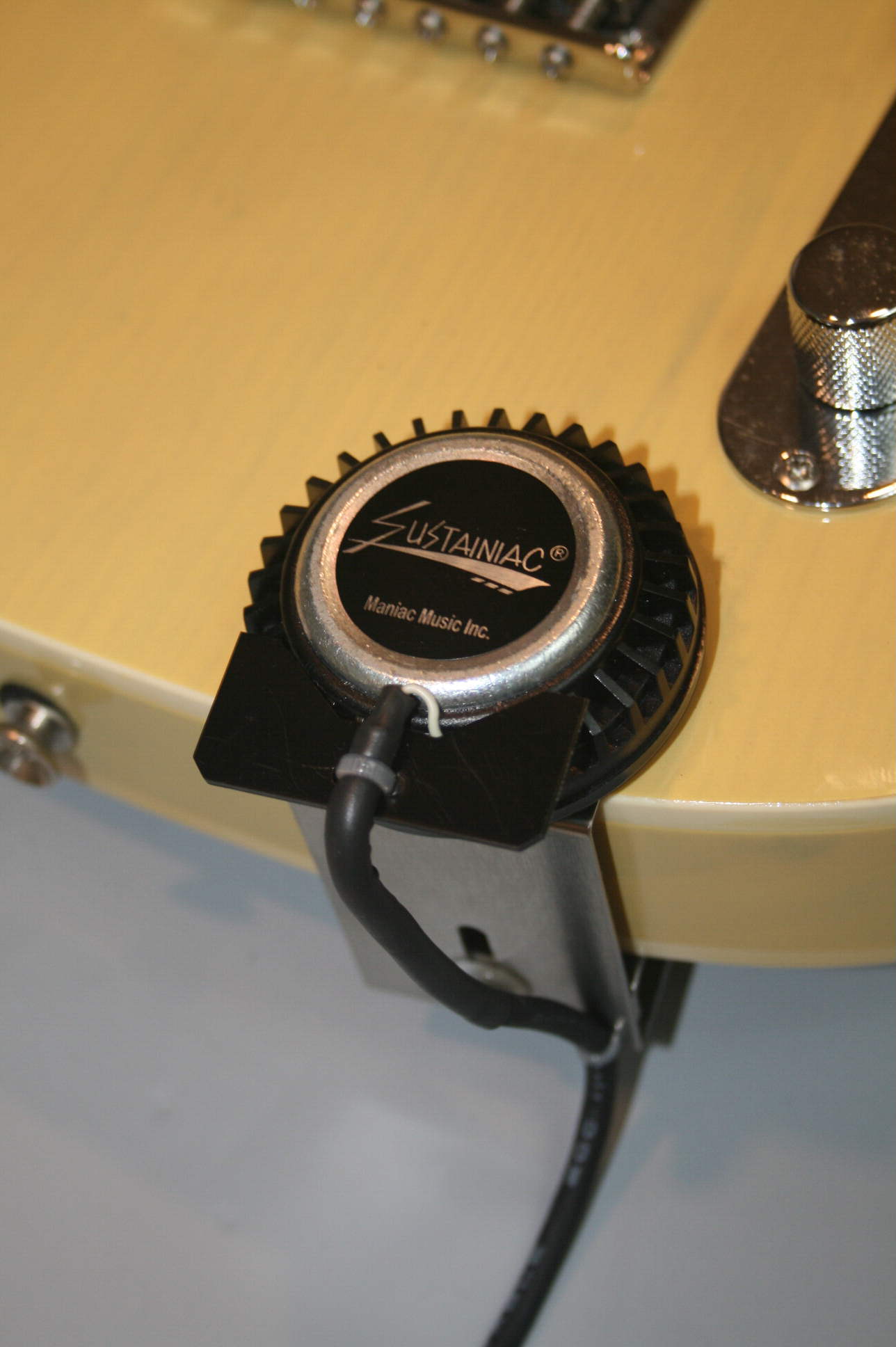
|
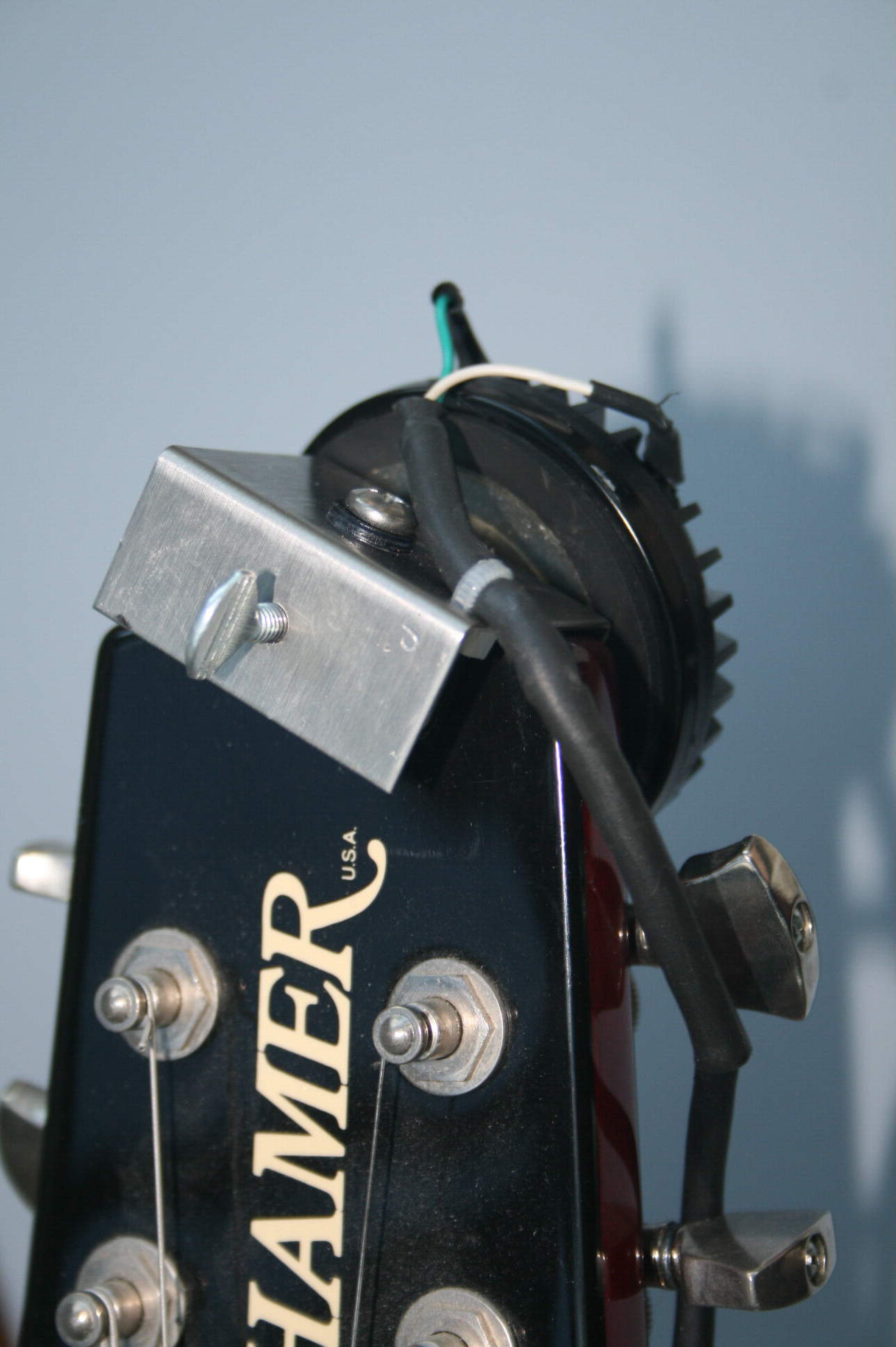 |
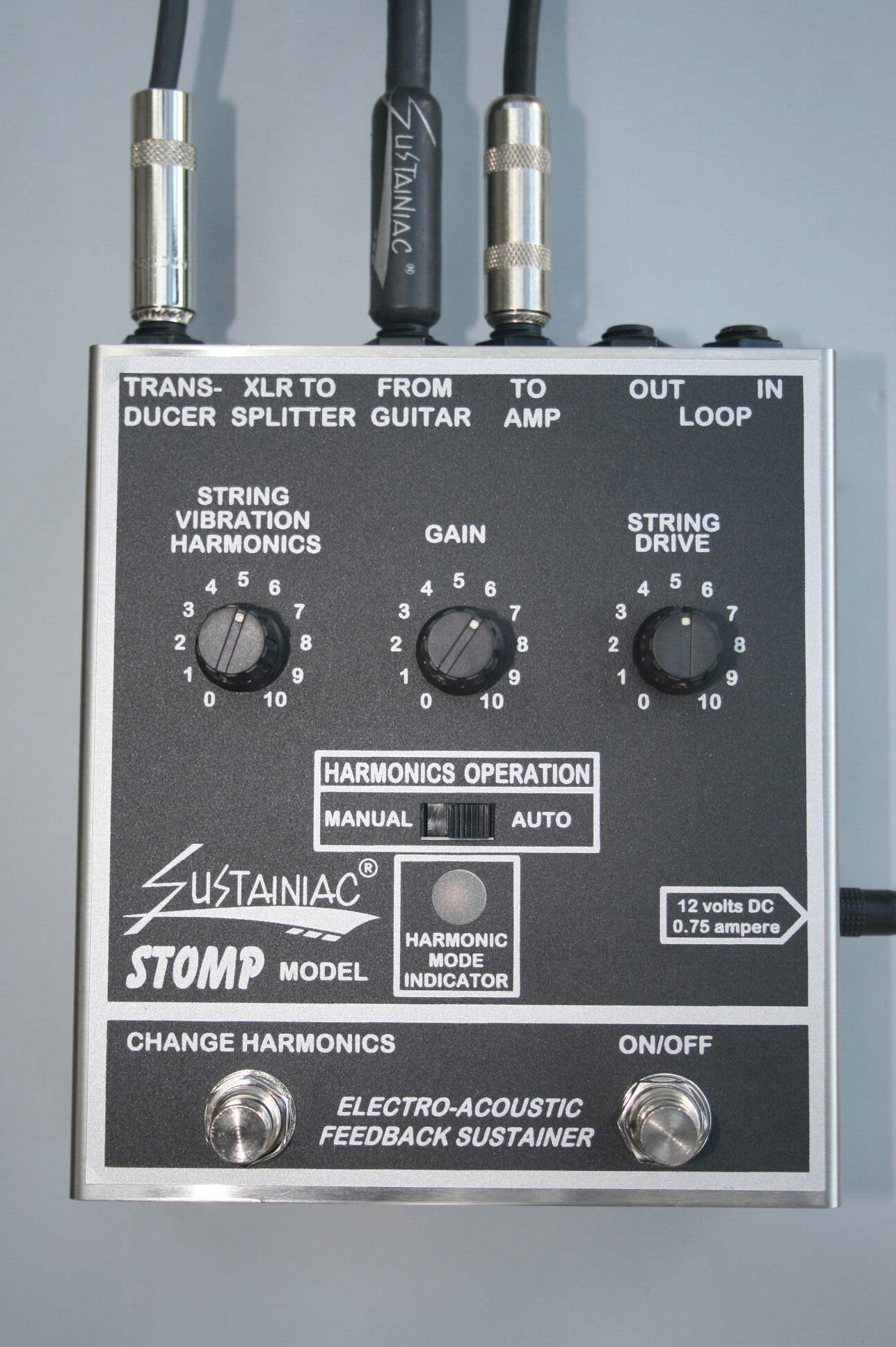
|
 Note that Transducer mounts to the back. |
TOPIC LIST
Overview of the SUSTAINIAC Stomp Model sustainer
Pricing and Options
Optional cord-routing system
Features and Controls
Switches: ON/OFF, Dual Mode Harmonic Select control, and CHANGE HARMONICS slide switch
Knob Functions
No Installation Required
Performing with the Stomp Model
Comparison of Stomp Model with Stealth PRO and other electromagnetic sustainers
How intense is it?
Guitars with piezo and other bridge types
Specifications:
Warranty
Overview of the SUSTAINIAC Stomp Model sustainer
The Sustainiac Stomp Model sustainer is an electroacoustic type sustainer. It makes your string vibrations sustain by making feedback. It is like getting natural amp feedback from a very large, loud amp. Only it is much, much more intense and predictable. Amp feedback often fails to work because of room acoustics from place-to-place. With the Sustainiac Stomp Model sustainer, you get successful and predictable intense feedback sustain at any volume level. Go to the ABOUT SUSTAIN page for a more thorough explanation of this phenomenon. The Stomp Model consists of two separate parts: The string-driver transducer and the Stomp Box controller/amplifier. The Stomp Box takes your guitar signal, amplifies it, and then sends this amplified signal to the transducer.
The 16 ohm transducer can clamp to the body or headstock, or stuck on the body with its built-in adhesive. See above photos. The transducer produces sound vibrations that reach the strings through the bridge or neck, depending on where you mount it. You can feel the instrument vibrate as you play. The notes will sustain their vibration for as long as you want them to. Using a vibrato, you can do dive bombs like never before. Do not use any transducer having less than 16 ohms. It risks damaging the Stomp Box amplifier and voids the 1-year warranty.
The SUSTAINIAC STOMP Model produces the strongest sustained string vibration of any previous electro-acoustic sustainer we have ever made, going back to 1987 with our Model B. Or anybody else as far as we know. Furthermore, you can clamp the new transducer to the body of most electric guitar models, near the output jack. This greatly simplifies dealing with the transducer cord. No more transducer cord hanging from the headstock. (Unless that's what you want.) The Stomp Model sustain intensity is better with body-mounting than any of our previous electro-acoustic models with headstock-mounting. If you find a "sweet-spot" where the transducer functions best on the body, you can order another transducer with no clamp for $50.00 and stick it onto the body with the included 3M double-stick tape. This might react with guitar finishes. So stick it to the back, not the front. Or route a hole and stick it in there.
The Stomp transducer turns the guitar body into a loudspeaker. If you are recording direct and have nearby microphones for voice etc., the mic will pick up the rather loud vibrations. If this is annoying, cover the transducer with foam or cloth to help mute the airborne sound vibrations.
INSTANT SUSTAIN: One main advantage of the Sustainiac Stomp Model electro-acoustic-type sustainer is that no special installation is needed. As soon as you take it out of the box, the transducer can be clamped to the guitar headstock, and you are sustaining in a few minutes.
Pricing and Options
The SUSTAINIAC Stomp Model sustainer basic price is $329. It includes the floor Stomp Box plus a 16 ohm transducer with body clamp and 10 ft. cord or headstock clamp and 13 ft. cord. Do not use any transducer having less than 16 ohms. It risks damaging the Stomp Box amplifier and voids the 1-year warranty. We have two basic options on mounting the transducer, and also an enhanced transducer "cord-routing-system". See the following.
DUE TO COVID-RELATED PRODUCTION SHORTAGES, WE ARE NEARLY OUT OF SHIELDED WIRE FOR OUR TRANSDUCERS. WE WON'T RECEIVE MORE UNTIL MARCH, 2023. THEREFORE, WE ARE LIMITING ALL BODY CLAMP WIRE LENGTHS TO 10 FT UNTIL THE SHORTAGE IS RESOLVED.
BODY CLAMP OPTION: This has a body clamp transducer. as shown below, with a standard 10-ft. (3.05 meter) transducer cord. The body clamp opens to 1.875 inches. (47.5mm). The body clamp will fit most solid guitar bodies. It opens to 1.875 inches. (47.5mm). You can attach the 10 ft. transducer cord to a standard 10 ft. guitar cord, with nylon ties. This makes a pseudo-single-cord. For an extra $10.00 you can order a longer 15 ft. transducer cord to match standard 15 ft. guitar cords. Extra transducer with Body Clamp is $75.00.
HEADSTOCK CLAMP VERSION: This was the only option available on our previous three electroacoustic sustainer models. We still offer it. But we suspect that most people will opt for the body-mount transducer. The headstock clamp will fit many guitar headstocks. It has a standard 10 ft. cord. The cord can be routed from the transducer directly to the stompbox transducer jack. Or, a longer 13 ft. cord (add $6.00) can be routed around a standard guitar strap, attaching to it with nylon ties as shown below. The extra 3 ft. is needed to match up with a standard 10 ft. guitar cord. An optional 18 ft. cord for an extra $10.00 mounts to a standard 15 ft. guitar cord. As you can see, the body-mount transducer is much easier to deal with than the headstock transducer. Extra transducer with Headstock Clamp is $75.00.
Since this is a new product, we don't know which mounting type will become most popular (body or headstock). But the robust sustain produced by the body-mounted transducer with this new Stomp Model tells us that we could have a hit on our hands. It is just too cool. Other cord lengths can be ordered. Add $2.00 per ft. over 10 ft.
Both clamps have a 1/16 inch (1.5mm) foam neoprene pad on the moveable side of the clamp for gripping the guitar body. The transducer side of both clamps is steel with no pad. This is because the steel transfers transducer vibrations to the wood of the body or headstock. We include a thicker, 1/4 inch foam neoprene pad that can be used to press against the top of a contoured body as shown in the lower right photo above. This places the transducer on the back of the body.
The transducer cord has a standard stereo phone plug that inserts into the 1/4 inch "TRANSDUCER" phone jack in the Sustainiamp floor box. For an extra $10, we can substitute a 15 foot transducer cord. This mates well with a standard 15 ft. guitar cord.
The new Stomp Model transducer weighs 6 ounces (170g), less cord. The cord weight depends on the length. No mounting with glue or screws.
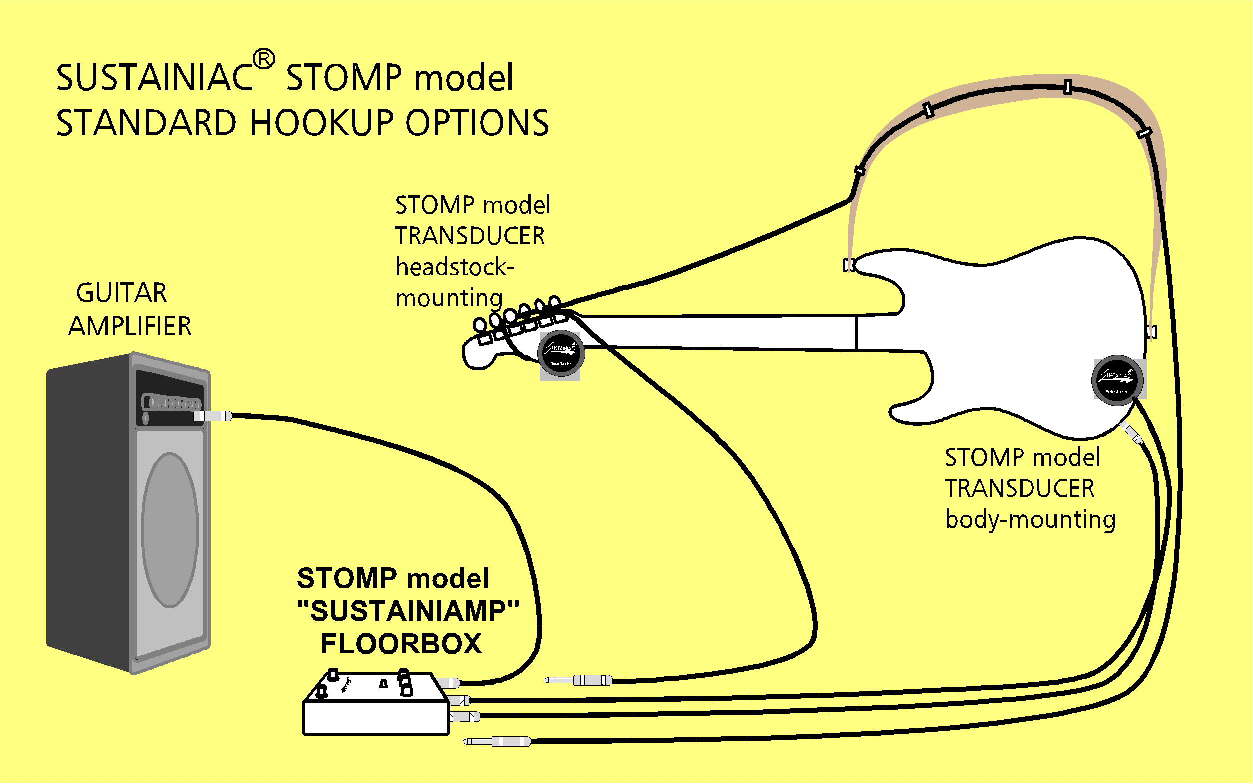
OPTIONAL CORD ROUTING SYSTEM (see picture below) This adds $100.00. We have resurrected this from the descontinued Model C. Some people objected to having a second cord hanging down from the guitar. A small junction box fastens to the strap near the bottom strap button. The transducer cord plugs into the junction box. An 18-inch guitar cord comes out of the box, and plugs into your guitar. A single 10-ft (or optional 15-ft) cable runs from the junction box down to the Sustainiac control box on the floor. This single cable carries the guitar signal down to the floor, and also the Stomp Model transducer drive signal up. So, you end up with only a single cable that you have to drag around. For 15 ft. cord-router cable, add $20 ($120 total).
But honestly, with the strong performance of the body-mount transducer, the cord-routing system might not have the appeal that it previously had.
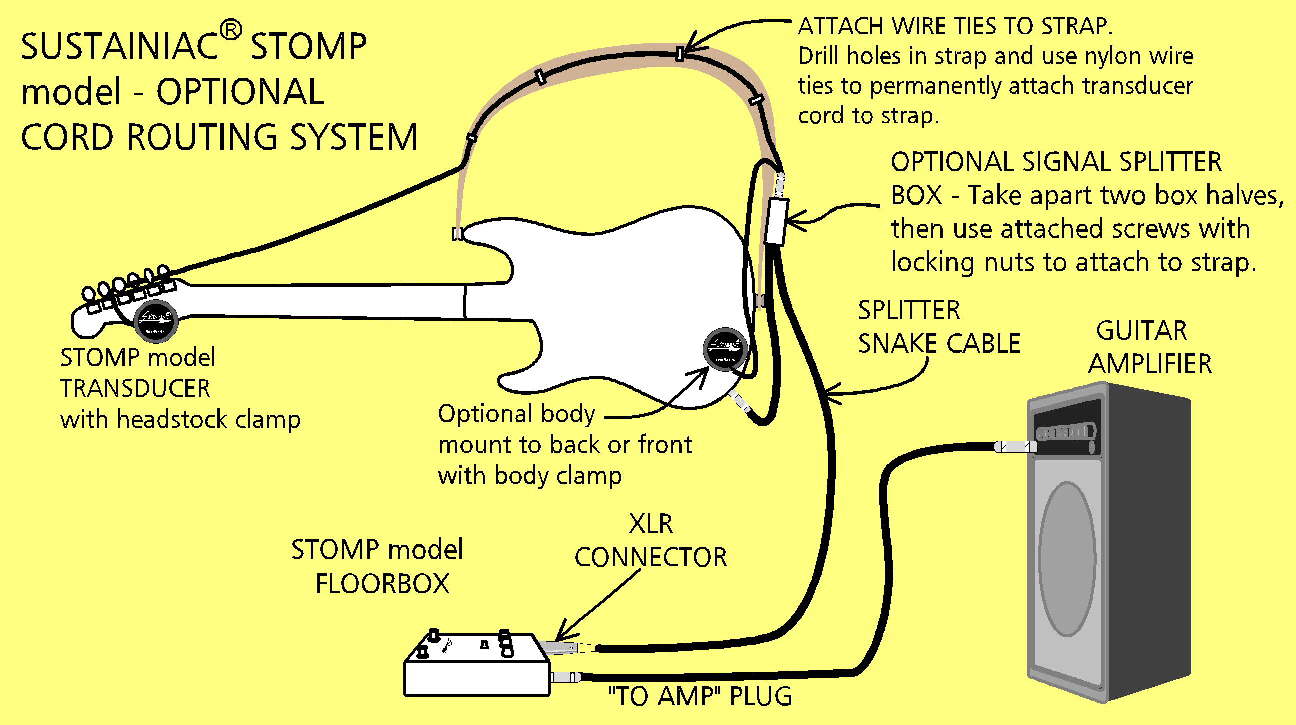
Features and Controls See diagram below.
TRANSDUCER: The 1/4 inch TRS plug of the transducer transducer connects to the TRANSDUCER TRS jack on the box.
XLR TO SPLITTER: The XLR TO SPLITTER jack is for the optional cord-routing system. A single snake cable carries the guitar signal down the snake to the Sustainiamp, and also carries the transducer drive signal up the snake to the transducer. When using the cord-routing option, you don't have to use the GUITAR IN or the TO AMP jacks.
FROM GUITAR: The FROM GUITAR jack connects directly to your instrument cord. You don't use it if you have the optional cord-routing system.
TO AMP: The TO AMP jack connects to your instrument amplifier or effects chain. The TO AMP jack is hard-wired to the FROM GUITAR jack. Therefore, only your raw, unprocessed guitar signal goes to your amp/effects. You don't use it if you have the optional cord-routing system.
LOOP - OUT/IN: The effects loop is for the Sustainiac processing signal only. You do not hear any effects connected here in your guitar signal. You can put a graphic equalizer in here to tailor the Sustainiac response to a particular guitar for an important recording session. Or, you can put a WAH-WAH pedal and actually squeeze several harmonics out of a single note. Or, a short adjustable time delay (1-10 milliseconds) will accomplish the same thing. A compressor pedal will actually enhance sustain. In short, using this effects loop, you can do things with an electric guitar that no one has ever thought of before.

Stomp foot-switches: ON/OFF and CHANGE HARMONICS. See diagram above.
The footswitches control the sustainer ON/OFF function and also the harmonics of sustained string vibration.
The Stomp Model has two modes of operation: MANUAL and AUTOMATIC. A slide switch on the control panel allows you to run in either mode. In either mode, you can force the harmonic mode to change from RED to GREEN and vice-versa by stepping on the CHANGE HARMONICS footswitch. A dual-color LED lights up either GREEN or RED, to let the user know which harmonic is being played. But in AUTO mode, you can force harmonic changes in another way: Simply lightly touch a vibrating string, or quickly reduce fretting pressure for an instant, and you can force the note to change harmonic vibration mode. Also, in AUTO mode, if a note happens to be out of phase with the sustainer vibration that travels up the neck to the fret, AUTO mode will take the quickly decaying note and change modes, turning the note into a robustly vibrating note.
Control Knob Functions:
STRING VIBRATION HARMONICS: Changes the frequency equalization of the Sustainiac signal path. Rotating this control full clockwise allows all highs to pass, but attenuates the lows. You get mostly harmonics in sustained vibration. Middle rotation allows both highs and lows to pass. You get both harmonics and fundamentals in sustained vibration. Rotating full counterclockwise allows all lows to pass, but attenuates the highs. You get more fundamentals in this position.
GAIN: Determines how fast sustained string vibration builds up. Full gain produces instantaneous sustain. Lower gains take longer to build up sustained vibration and harmonic changes.
STRING DRIVE: This control controls final power amplifier gain. Like the GAIN control, it also determines how fast sustained vibration builds up. DRIVE also controls how strong the final sustained string vibration will be. It also overlaps the above-mentioned GAIN control, but GAIN doesn't affect final string vibration amplitude.
DIFFERENCE BETWEEN DRIVE AND GAIN: People often ask what the difference is between these two functions. First, they are both similar in that they both change the overall system gain. This determines how fast the sustained vibrations build up. The important difference is this: The DRIVE function also controls how much energy is actually delivered to the strings. As you hold a sustained note and adjust the DRIVE knob up and down, you can see the string vibration amplitude change. If you have an ac line power meter or current meter, you will also see this change in response to DRIVE knob settings. With changes in GAIN setting, you will not see the amplitude change. One way to think of it is to compare these two settings to the PRE-GAIN and POST-GAIN settings of a typical distortion box. The PRE-GAIN setting controls the amount of distortion that the signal has. The POST-GAIN setting controls the volume of the signal. But both settings control the overall amount of system gain.
AUTOMATIC MODE: The Sustainiac Stomp Model offers a novel way of changing the harmonic mode of operation. We have included the Automatic mode from the discontinued Sustainiac Model C, where the player can force the harmonic mode to change without having to step on the switch. You simply touch the vibrating string lightly for an instant, and the mode will change. Or, you can simply reduce fretting pressure for an instant. A special circuit inside the Stomp Model responds to a decaying note. (We invented it to prevent the occasional dead fret that you get when the vibration energy from the transducer reaches the string out of phase with the string vibration.) It works for this, but we found it cool to be able to touch the string and get the harmonic change. You can still step on the switch and cause the harmonic change with your foot.
EFFECTS LOOP: We have included an effects loop on the Sustainiac control box that only functions on the transducer signal. You can add an equalizer or other effect (such as volume control, wah-wah, or time delay) to tweak the operation of the Stomp Model. Using a wah-wah or small time delay (1-10 milliseconds) you can actually change single sustained note harmonics several times. But you don't hear the "wah-wah" or time delay function, because it is not in the signal loop that you hear. It is only in the Sustainiac signal path. /DIR>
No Installation Required
This is the main difference between an electroacoustic sustainer and an electromagnetic sustainer. For more differences, go to the page which describes MAGNETIC VS.
ACOUSTIC SUSTAINERS. The Stomp Model doesn't have to be installed inside of the instrument, like a magnetic type of sustainer does. All of your instrument pickups work with the Stomp Model.
Again, this is unlike a magnetic type of sustainer where only the bridge pickup typically works when the sustainer is on. You can use several guitars at a recording session and use the Stomp Model with all of them.
Performing with the Stomp Model
Most sustained notes will morph into cool-sounding harmonics within a short time after the note is played. The morph time depends on how high you turn up the GAIN and/or DRIVE control.
Some notes will remain as fundamental vibration. Then, you can force the note to fade into a harmonic by stepping on the HARMONIC CHANGE footswitch. Some chords will sustain two or three notes, but most morph into a
single note after several seconds.
Following are some playing tips for sustainer users:
(1) LET THE SUSTAINER TAKE OVER THE PLAYING DYNAMICS: Heavy-handed pickers get immediately frustrated and confused by sustainers. When you dig in real hard with a heavy pick, a lot of vibration energy is put into the string. The string vibration amplitude will have to die out some to reach the level where the sustainer energy takes over. This can make for an un-natural playing experience.
The idea is to play with a light picking touch when you are using the sustainer. Use hammer-ons and tapping where convenient. Then, the sustainer makes the notes swell instead of "dying down" to the sustainer energy level. This adds a new twist to playing, and is the key to making a sustainer an essential part of your "bag 'o tricks".
(2) GETTING USED TO FEEDBACK: If you are used to playing at a loud volume, you get feedback from your amplifier. You have probably developed your technique so that you automatically hand mute the strings that aren't being played. This keeps them under control, so that they don't feed back when you don't want them to. It is natural for you. Playing in front of a large, loud amplifier can make handling the guitar like trying to drive a race car. Particularly if you play a hollow or semi-hollow body guitar. On the other hand, if you are an "unplugged" acoustic player, or only practice quietly at home, you probably don't hand mute. At first, playing with SUSTAINIAC may seem frustrating, because the strings try to jump to life when you don't want them to. After a little getting used to, hand muting becomes second nature.
Comparison of Stomp Model with Stealth PRO and other electromagnetic sustainers
People often ask about how the feedback sustain of an electroacoustic-type sustainer like the Stomp Model compares to that of an electromagnetic sustainer like the Stealth PRO. They ask questions like "Does the Stomp Model
tend to make 2nd or 3rd harmonics?". It turns out that it is not that simple.
With an electroacoustic sustainer like the Stomp Model, you can't really make a statement about what harmonic mode is going to dominate after the initial vibration period is over like you can with an electromagnetic sustainer like the Stealth PRO. What harmonic mode ends up for a particular note is determined strictly by the physics of how the transducer energy reaches the string.
Here is what happens: The pickup senses the string vibration, and sends this signal to the floorbox amplifier. The amplifier amplifies the pickup signal, and the sends this to the transducer. Sound travels from the transducer to the fret. For headstock-mounting, the distance from the transducer to a fret varies from about 6 inches to about 2 feet, depending on what fret is being used for that note. This takes about 0.1 to maybe 2 milliseconds, depending on what fret is being used. During this time period, the phase of the note will change from about 10 degrees to a full 360 degrees, depending on the note frequency and also upon the distance between transducer and fret. Furthermore, additional phase shift occurs due to the way pickups work. For body-mounting you can expect more fundamentals.
If the transducer energy that reaches the fret happens to be in phase with the string vibration, the sustained note vibration will be a fundamental. But most likely, the energy will be out of phase with the fundamental mode string vibration. How much out of phase depends on all the variables just explained. The energy will usually reach the string more or less in phase with SOME harmonic mode (but not necessarily). That is the mode that will end up being the final vibration mode of the string at the particular fret being used. The harmonic mode that is the most in phase with the energy reaching the string has the most gain, and therefore will "win out". But you cannot say you will get "second harmonics" or "third harmonics" as some people want to generalize, as you can understand from the above explanation. In some cases, the energy will reach the fret almost precisely 180 degrees out of phase with the string vibration, which quickly stops the note. If you are in AUTOMATIC mode, the sustainer will automatically change phase in this case, which then causes the vibration to be in phase with the note.
With chords, one note will typically win out because it has the most gain. But doubles and triples will often ring for some time before one note finally wins. <
How intense is it?
The sensation of playing with the Sustainiac Stomp Model sustainer is indeed intense
and exciting. Musicians often say that it feels like the instrument is actually alive in their hands. Yes, you definitely feel the
vibrations! This sensation is like playing at extreme, deafening volume levels. Yet, the instrument amplifier volume can be turned
all the way down to zero. The intensity and responsiveness are fully adjustable. Play screaming solos all night in your
home, without the police showing up! Curious people often ask us if this vibration will harm their guitar. We have had
the Model B on our demo guitars for over 30 years now (some of them valuable vintage instruments) and the Model C since 2003. We have never had
any damage to our guitars. Nor has anybody in all these years ever reported such damage to us, not even a tuner screw backing out.
Sustain of notes with an electro-acoustic sustainer tends to be much like that of natural feedback that you get from a loud amplifier: Most notes change into cool-sounding harmonics within a short time after the note is played. Some notes will remain as fundamental vibration. Then, you can force the note to go into a harmonic by stepping on the appropriate footswitch. The best part is that you donít have to play at a loud volume to get screaming feedback sustain! The sensation of playing with the Sustainiac Stomp Model sustainer is very intense and exciting. Musicians often say that it feels like the instrument is actually alive in their hands. This sensation is like playing very, very loudly, yet the instrument amplifier volume can be turned all the way down to zero.
Guitars with piezo and other bridge types
We have also had some success on acoustic guitars having piezo and other bridge types. With piezos, you should have
a built-in preamp to boost the piezo signal, and also to lower its output impedance. One particularly good transducer for this
is the Schertler Bluestick undersaddle transducer. The Bluestick is designed to be an acoustic guitar pickup.
This is actually a small condenser microphone that is
contained inside a small under-saddle tube. These might not be available anymore. Schertlerusa.com
With the Bluestick, you can actually mount the transducer directly on the bridge, because it doesn't respond at all to the
magnetic field that radiates from the Stomp Model transducer. What is interesting is that you get
good fundamentals with this, because there is no time delay between the transducer output and the string ends. We have
not done any long break-in experiments with the Bluestick, to determine whether or not this will damage the transducer. If
you are brave and have cash to experiment, this might make a lot of acoustic players happy.
Specifications: Power consumption: 4.5 watts, 120 volts, 50/60 Hz. (Also European 220/240 volts, 50 Hz, Japanese 100 volts 50 Hz)
Wall type supply is 9 volts DC, 1 ampere minimum requirement.
Input impedance: 1Meg ohm;
Transducer: impedance: 16 ohms, weight 6 oz (not including cord). Shipping weight: 5lbs. Amplifier: Weight 1 lb, 15 oz. length 6 in, width 5.25 in., height 2.6 in.
DO NOT USE ANY TRANSDUCER WITH LESS THAN 16 OHMS IMPEDANCE WITH THE STOMP BOX. It risks damaging the Stomp Box amplifier and voids the 1-year warranty. .
Warranty: One year from date of purchase.
5348 N. Tacoma Ave., Indianapolis IN 46220 Phone: 317-340-1161
email: info@sustainiac.com